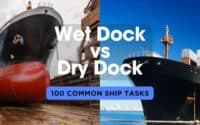The lifespan of 20 Key components on Ships

In the maritime industry, the longevity of ship components is crucial for operational efficiency and safety. This guide explores the lifespans of 20 key components of commercial ships, from engines and hulls to navigation systems and safety gear. We’ll discuss factors affecting their durability, provide average lifespan estimates, and offer maintenance tips to help shipowners and operators maximize the performance and lifespan of their vessels.
* Please send feedback/suggestions to editor @ shipuniverse.com
1. Engine
Factors Affecting Lifespan:
- Operational Intensity: Frequent high-load operations can accelerate wear.
- Maintenance Regime: Regular and thorough maintenance is crucial for longevity.
- Fuel Quality: High-quality fuel with fewer impurities can significantly reduce engine wear.
- Environmental Conditions: Saltwater and humid environments can promote corrosion.
Average Lifespan:
The average lifespan of a ship’s engine is around 20 to 30 years, though well-maintained engines can last beyond this range.
Maintenance Tips:
- Conduct regular oil changes and routine maintenance as per manufacturer guidelines.
- Perform frequent inspections for any signs of wear or damage and address them promptly.
- Keep detailed logs of all maintenance activities to track the engine’s health over time.
2. Propeller
Factors Affecting Lifespan:
- Material and Construction: Higher quality materials generally last longer.
- Water Conditions: Sandy or icy waters can cause abrasion and physical damage.
- Maintenance Practices: Regular checks and maintenance can prevent long-term issues.
- Marine Growth: Organisms can attach to the propeller, decreasing efficiency and increasing stress.
Average Lifespan:
A ship’s propeller will usually last between 10 to 20 years, depending on its material and environmental conditions.
Maintenance Tips:
- Regularly clean the propeller to prevent biofouling and ensure optimal performance.
- Inspect the propeller for signs of erosion, corrosion, or damage, especially after operating in abrasive conditions.
- Balance the propeller periodically to reduce vibrations and associated wear on the propulsion system.
- Apply protective coatings if operating in highly corrosive environments.
3. Hull
Factors Affecting Lifespan:
- Material Quality: Modern ships are typically constructed from steel or aluminum. Steel is highly durable but prone to corrosion, while aluminum is lighter and less corrosive but can suffer from fatigue.
- Environmental Conditions: Exposure to saltwater greatly accelerates corrosion, and operating in ice-infested waters can cause additional physical stress.
- Maintenance Practices: Regular inspections, timely repairs, and protective coatings (like anti-fouling and anti-corrosive treatments) are crucial.
- Design and Construction: The design should efficiently distribute stress and avoid areas that might trap moisture or encourage rust.
Average Lifespan:
The lifespan of a ship’s hull can greatly vary. Steel hulls, with rigorous maintenance, can last well over 30 years. Some well-maintained hulls have remained in service for up to 50 years, but this requires exceptional maintenance practices and operational conditions.
Maintenance Tips:
- Conduct frequent inspections for any signs of corrosion, particularly in welded areas and below the waterline.
- Apply anti-fouling and anti-corrosive coatings regularly to protect the hull surface.
- Perform dry docking as per regulatory requirements to thoroughly inspect and repair the hull.
- Ensure that drainage systems on the deck are clear to prevent standing water, which can accelerate corrosion.
4. Fuel Tanks
Factors Affecting Lifespan:
- Material Quality: Typically made from robust materials like steel, which must be corrosion-resistant.
- Installation Quality: Proper installation and stable mounting reduce stress and potential damage.
- Operational Practices: How the fuel is maintained, including moisture and impurity levels, affects tank longevity.
- Environmental Conditions: Exposure to saltwater and extreme temperatures can lead to corrosion.
Average Lifespan:
Fuel tanks on ships can last up to 30 years, depending on maintenance and environmental factors.
Maintenance Tips:
- Regularly inspect tanks for any signs of corrosion, wear, or leakage.
- Ensure that vents and filters are clean to prevent contamination.
- Monitor and maintain proper fuel levels to avoid moisture accumulation.
- Apply protective coatings inside and outside the tank to resist corrosion.
5. Navigation Equipment
Factors Affecting Lifespan:
- Technological Advancements: Rapid advancements in technology can render older systems obsolete.
- Operational Conditions: Exposure to harsh maritime environments like salt air and vibration can degrade sensitive components.
- Maintenance Practices: Regular updates and careful handling are essential to ensure longevity.
- Quality of Equipment: High-quality, durable equipment designed specifically for marine conditions tends to last longer.
Average Lifespan:
While physical components like radar antennae can last up to 20 or more years, electronic components such as software might need updates or replacements more frequently to keep up with technological advances.
Maintenance Tips:
- Regularly update software to ensure compatibility with new technologies and improved functionalities.
- Perform routine checks and calibrations to ensure all navigation systems are accurate and fully functional.
- Protect equipment from exposure to the elements as much as possible.
- Train crew on proper handling and troubleshooting techniques to minimize accidental damage.
6. Lifeboats and Safety Equipment
Factors Affecting Lifespan:
- Regulatory Requirements: Frequent updates in safety regulations may necessitate earlier replacement to meet new standards.
- Material Degradation: Materials can degrade over time, especially when exposed to harsh marine environments.
- Usage: While ideally unused, lifeboats and safety equipment must be ready for immediate deployment, and any usage can influence future functionality.
- Maintenance Practices: Regular inspection and maintenance are crucial to ensure readiness.
Average Lifespan:
Lifeboats are designed to last as long as the vessel but require regular maintenance and component replacements. Other safety equipment, like life jackets and flares, typically have shorter lifespans and specific expiration dates.
Maintenance Tips:
- Regularly inspect and service lifeboats to ensure they are in perfect working condition.
- Check safety equipment for any signs of wear or expiration and replace as necessary.
- Conduct safety drills to ensure all equipment is functional and the crew is familiar with their use.
- Store equipment in accessible, protected locations to minimize exposure to the elements.
9. Anchors and Mooring Systems
Factors Affecting Lifespan:
- Material Quality: The durability of materials used for anchors and chains, typically steel, plays a significant role in their longevity.
- Environmental Exposure: Constant exposure to marine environments can lead to corrosion and wear.
- Operational Stress: Frequent deployment and high loads can strain the system.
- Maintenance Practices: Regular inspections and maintenance can extend lifespan and ensure reliability.
Average Lifespan:
The lifespan of anchors and mooring systems can vary, but typically, anchors and chains can last up to 15-25 years with proper care and under normal operating conditions.
Maintenance Tips:
- Regularly inspect anchors, chains, and ropes for signs of corrosion, wear, or damage.
- Ensure that all moving parts are lubricated to prevent rust and ensure smooth operation.
- Replace worn or damaged components promptly to maintain system integrity.
- Perform load tests periodically to verify that the system can handle specified forces.
10. Ballast Water Systems
Factors Affecting Lifespan:
- Operational Practices: Proper management and operation of the system are crucial to prevent mechanical failures and contamination.
- Maintenance Frequency: Regular maintenance is essential to ensure valves and pumps are functioning correctly.
- Environmental Regulations: Compliance with international standards for ballast water to prevent environmental contamination affects system upgrades and management practices.
- Material Quality: Corrosion-resistant materials extend the lifespan of the system components.
Average Lifespan:
Ballast water systems can last about 15-25 years, depending on the materials used and how rigorously the system is maintained.
Maintenance Tips:
- Regularly inspect and clean tanks and related equipment to prevent sediment build-up and corrosion.
- Test and maintain all mechanical components, such as pumps and valves, to ensure they are in good working order.
- Implement a ballast water management plan that complies with the latest maritime environmental regulations.
- Use treatments or filtration systems to prevent the introduction of invasive species through ballast water discharge.
11. Fire Suppression Systems
Factors Affecting Lifespan:
- Maintenance and Inspection: Regular testing and maintenance are essential for ensuring that fire suppression systems are operational when needed.
- Technological Upgrades: Advances in technology may require system upgrades to meet new safety standards.
- Operational Conditions: Exposure to harsh environments and the frequency of system activation can impact lifespan.
- Installation Quality: Proper installation and integration with other ship safety systems are critical for effective performance.
Average Lifespan:
The components of fire suppression systems, such as extinguishers and sensors, typically need to be replaced or extensively serviced every 5 to 15 years, depending on the specific equipment and manufacturer guidelines.
Maintenance Tips:
- Conduct regular inspections and maintenance checks as per the manufacturer’s and maritime safety regulations.
- Train the crew on the proper use and routine checks of fire suppression equipment.
- Replace components and refill agents (like extinguishing powders and gases) according to the specified schedules.
- Ensure that all system sensors and alarms are fully functional and free from blockages or damage.
12. HVAC Systems
Factors Affecting Lifespan:
- Operational Demand: The intensity and frequency of use, particularly in extreme weather conditions, can wear down components more quickly.
- Environmental Conditions: Salt air and moisture can cause corrosion and system degradation.
- Maintenance Practices: Regular cleaning and servicing of filters, ducts, and mechanical parts are crucial for system longevity.
- Quality of Components: High-quality components designed for marine environments can significantly extend the system’s lifespan.
Average Lifespan:
HVAC systems on ships can last approximately 10-15 years, depending on their usage, maintenance, and environmental conditions.
Maintenance Tips:
- Regularly clean and replace air filters to maintain air quality and system efficiency.
- Inspect and clean ducts and vents to ensure unobstructed airflow.
- Check and maintain refrigerant levels and check for leaks regularly.
- Service the system’s mechanical components, such as fans and compressors, to prevent failures.
13. Rudder and Steering Systems
Factors Affecting Lifespan:
- Material and Design: Quality materials and robust design are essential to withstand the mechanical stresses and corrosive marine environment.
- Usage Frequency: Frequent changes in course and high-stress maneuvers can accelerate wear.
- Maintenance Practices: Regular inspections, lubrication, and timely repairs are crucial for long-term functionality.
- Environmental Conditions: Saltwater exposure can lead to corrosion, particularly on metallic components.
Average Lifespan:
With proper maintenance, rudders and steering systems can typically last for the lifespan of the ship, although specific components like seals or hydraulic fluids may need more frequent replacement or servicing.
Maintenance Tips:
- Regularly inspect and lubricate moving parts to reduce wear and prevent failures.
- Check hydraulic systems for leaks and maintain fluid levels to ensure smooth operation.
- Conduct periodic alignment checks to ensure the rudder and steering mechanisms are properly calibrated.
- Replace worn components like bearings and seals as needed to maintain system integrity.
14. Communication Systems
Factors Affecting Lifespan:
- Technological Advancements: Rapid advancements in communication technology can render older systems obsolete.
- Environmental Exposure: Equipment exposed to harsh marine conditions is susceptible to degradation.
- Usage Patterns: Frequent and intensive use can wear out electronic components more quickly.
- Maintenance and Upgrades: Regular updates and maintenance are necessary to keep communication systems operational and effective.
Average Lifespan:
While the hardware of communication systems such as antennas and radios can last 10-20 years, software components and connectivity technologies may require upgrades more frequently to keep pace with new advancements and standards.
Maintenance Tips:
- Perform regular system checks to ensure all communication devices are functioning correctly.
- Protect equipment from environmental exposure as much as possible.
- Update software and firmware regularly to maintain compatibility with global communication standards.
- Train the crew on the proper use of all communication equipment to minimize user-induced errors and ensure effective operation in emergencies.
15. Stabilization Systems
Factors Affecting Lifespan:
- Mechanical Stress: Regular exposure to high seas and the associated mechanical stress can wear down components.
- Maintenance Practices: As with most mechanical systems, regular maintenance is key to longevity.
- Technological Advancements: Innovations in stabilization technology may necessitate upgrades to more efficient or effective systems.
- Environmental Conditions: Saltwater and marine environment exposure can lead to corrosion, impacting system components.
Average Lifespan:
Stabilization systems generally have a lifespan of around 10-15 years, depending on the type of system and the level of maintenance provided.
Maintenance Tips:
- Regularly inspect mechanical components for signs of wear or damage.
- Ensure hydraulic systems are leak-free and have adequate fluid levels.
- Perform routine system tests to ensure they are responsive and effective.
- Keep electronic controls and sensors in good working condition through regular checks and calibration.
16. Water Treatment Systems
Factors Affecting Lifespan:
- Quality of Input Water: The quality of seawater and onboard water sources can affect the system’s efficiency and wear.
- Maintenance Frequency: Regular maintenance and replacement of filters and membranes are crucial for optimal operation.
- Technological Upgrades: Advancements in water treatment technology can lead to system updates for increased efficiency and compliance.
- Operational Conditions: Frequent use and the chemical properties of treated substances can degrade system components.
Average Lifespan:
Water treatment systems can last between 10-20 years. Components like pumps and filters, however, may require more frequent replacements depending on usage patterns.
Maintenance Tips:
- Regularly replace consumable components such as filters and membranes.
- Monitor system performance through routine testing of water quality before and after treatment.
- Clean and descale processing units to prevent buildup and ensure efficiency.
- Keep chemical treatment feeds checked and refilled as necessary to maintain water quality.
17. Thrusters
Factors Affecting Lifespan:
- Operational Stress: High-frequency use, especially in complex navigational situations, can lead to wear.
- Maintenance Practices: Regular maintenance, including cleaning and lubrication, is essential to preserve the function and lifespan of thrusters.
- Environmental Exposure: Saltwater and debris can cause corrosion and physical damage to thruster components.
- Installation Quality: Proper installation and alignment are critical to prevent undue stress and wear.
Average Lifespan:
Thrusters can last between 10 to 20 years, depending on their usage intensity and the maintenance regimen followed.
Maintenance Tips:
- Regularly inspect thrusters for signs of wear or damage, especially after maneuvers in debris-rich waters.
- Clean and lubricate moving parts routinely to ensure smooth operation.
- Check for and address any corrosion issues promptly to prevent further damage.
- Ensure that the electrical components associated with thrusters are well-maintained and protected from moisture.
18. Shaft and Bearings
Factors Affecting Lifespan:
- Alignment and Installation: Proper alignment and installation are crucial to minimize stress and uneven wear.
- Operational Load: Continuous heavy loading can accelerate wear and fatigue.
- Maintenance Practices: Adequate lubrication and regular inspections are key to longevity.
- Environmental Conditions: Exposure to corrosive marine environments can degrade materials over time.
Average Lifespan:
With proper maintenance, shafts and bearings can last for the lifetime of the ship, though regular inspections might identify the need for more frequent maintenance or replacements of specific components.
Maintenance Tips:
- Regularly inspect shafts and bearings for signs of wear, corrosion, or misalignment.
- Maintain proper lubrication to ensure smooth operation and protect against wear.
- Perform vibration analysis periodically to detect early signs of imbalance or bearing failure.
- Address any alignment issues immediately to prevent further damage to the propulsion system.
19. Exhaust Systems
Factors Affecting Lifespan:
- Operational Conditions: High temperatures and corrosive exhaust gases can degrade components over time.
- Maintenance Practices: Regular inspections and cleaning are crucial to maintain system integrity and efficiency.
- Environmental Regulations: Compliance with stricter environmental standards may require upgrades or replacements to meet emission controls.
- Material Quality: Using corrosion-resistant materials can significantly extend the lifespan of exhaust components.
Average Lifespan:
Exhaust system components can last between 10 to 15 years, depending on the material and maintenance. Scrubbers and filters may need more frequent attention or replacement depending on usage and regulatory requirements.
Maintenance Tips:
- Regularly inspect the exhaust system for signs of corrosion, leaks, or damage.
- Clean and replace filters and scrubbers as required to ensure effective operation and compliance with emission standards.
- Use high-quality, corrosion-resistant materials for any replacements or repairs.
- Monitor system performance regularly to detect any inefficiencies or potential failures.
20. Generator Sets
Factors Affecting Lifespan:
- Operational Demand: Continuous or heavy use can lead to quicker degradation.
- Maintenance Schedule: Regular maintenance, including oil changes, filter replacements, and system checks, is vital for longevity.
- Environmental Factors: Exposure to salty air and moisture can accelerate corrosion and wear.
- Fuel Quality: Using clean, high-quality fuel is essential to prevent buildup and ensure efficient combustion.
Average Lifespan:
Generators can generally last around 20,000 to 30,000 hours of operation, translating to about 10 to 15 years with proper maintenance and operational care.
Maintenance Tips:
- Conduct regular maintenance as per the manufacturer’s guidelines.
- Ensure the generator is operated within its designed load parameters to avoid overstressing the system.
- Keep the generator set clean and dry, and protect it from environmental exposure as much as possible.
- Regularly test the generator under load to ensure it is ready for emergency situations.

Do you have a Maritime Product or Service that may be of interest to Shipowners? Tell us about it here!
Do you have feedback or insights? Please reach out to editor @ shipuniverse.com



